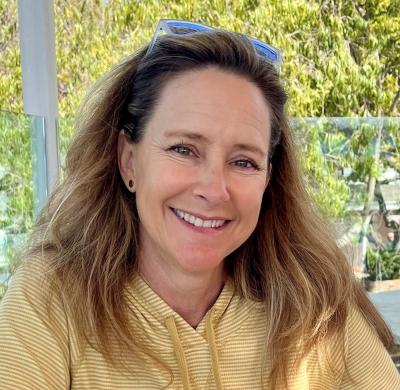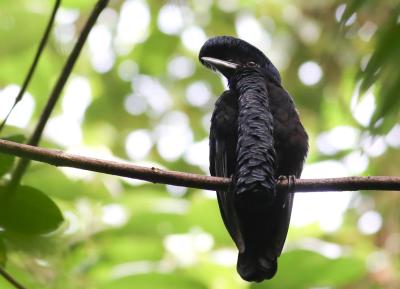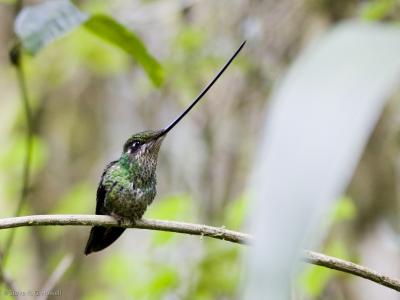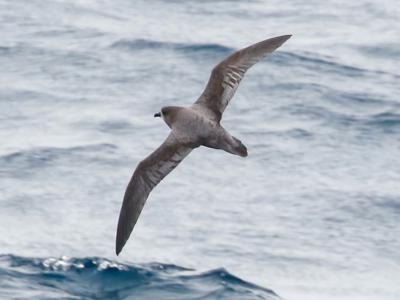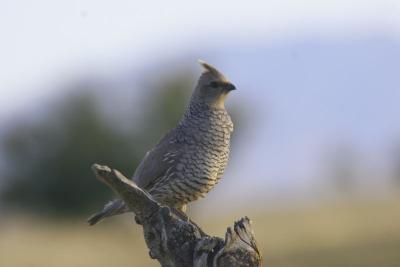California: Central and Southern
Pinnacles National Park, The Coast, Santa Cruz Island, the Salton Sea, and the Mojave Desert
-
Aug - Sep, 2025
Jon Dunn and Jon Feenstra
Tour Price to be Determined
Tour Price to be Determined
Central and Southern California may call to mind rampant development and crowds of people, but in fact it has many areas that are both wild and beautiful. Our tour focuses on birds that are difficult or impossible to see elsewhere in the United States. These include California Condor and the endemic Island Scrub-Jay and Yellow-billed Magpie, but there are many other species that occur primarily (and are easiest to find) in California. The tour takes place when fall migration for many species is at its peak.
We’ll visit the coast and Santa Cruz Island northwest of Los Angeles, coastal areas south of Los Angeles, the legendary Salton Sea, the high conifer forests in the San Gabriel Mountains, and the Mojave Desert.
Day 1: Arrivals and 6pm meeting and dinner. Night in San Jose.
Day 2: This morning after an early breakfast we will drive south to Pinnacles National Park. Along the way, through oak-savanna habitat, we’ll watch for Yellow-billed Magpies, a California endemic species and one that has declined in range and numbers due to West Nile Virus. Arriving at Pinnacles, we’ll scan the rocky outcroppings or overhead for California Condor. The last birds were taken from the wild in 1987 to breed in captivity, which eventually enabled releases back into the wild, and this is one of the best places to see free-flying birds. Morning and late afternoon are the best times to find them, as they fly off elsewhere to forage during the day. The east side of Pinnacles is surprisingly well-wooded, and we will search for a variety of oak-woodland species like California Quail, Acorn and Nuttall’s woodpeckers, Hutton’s Vireo, California Scrub-Jay, Oak Titmouse, Bushtit (coastal subspecies), White-breasted Nuthatch (coastal aculeata subspecies which calls very differently from all the other two subspecies groups), Bewick’s Wren, Western Bluebird, and California Towhee. In rocky areas we’ll search carefully for Canyon Wren and Rufous-crowned Sparrow. With good luck we might find Lawrence’s Goldfinch. There should be migrants around as well. Possibilities include a wide variety of western migrants, but amongst them include Pacific-slope Flycatcher plus Black-throated Gray and Townsend’s Warblers. We will plan on staying into the early evening to try for Western Screech-Owl and there is at least a chance for Northern Saw-whet Owl. It is about a 40-minute drive to King City where we will spend the night. Night in King City.
Day 3: If we have not had satisfactory views of Condors we will try again this morning. Otherwise, or later in the day, we will head south towards Morro Bay and coastal San Luis Obispo County. The rocky coastline there is quite beautiful, and the creek mouths can have a number of migrants, including rarities. The birding community in this area is quite active and we will be appraised of the latest sightings of interest. Rocky shorebirds like Black Oystercatcher, Surfbird, Black Turnstone and Wandering Tattler are all possible along with Brandt’s and Pelagic cormorants. Perhaps we might find a lingering Pigeon Guillemot, most of which will have migrated north. Later we’ll drive back to Atascadero. After dinner we might have a chance again to look for owls. Night in Atascadero.
Day 4: If we have missed Yellow-billed Magpie previously, we’ll search carefully for it this morning in the beautiful oak grassland areas east of Atascadero towards Creston. From here we will stop and bird along the rocky coastline at Pismo Beach where we will have additional chances to see rocky shorebirds. We will look on the ocean for Common Murre and perhaps a lingering Pigeon Guillemot, or summering Surf Scoters or a loon. Nearby Oceano is an excellent place for migrants, and we’ll look carefully for feeding flocks here. Chestnut-backed Chickadees and Hutton’s Vireo are resident. From here we’ll drive south through Santa Barbara, stopping to look for anything special that might be around before continuing on to Ventura. Night in Ventura.
Day 5: We’ll spend the morning crossing to Santa Cruz Island, the largest and most wooded of southern California’s Channel Islands. Once on the island we’ll hike gently in search of the Island Scrub-Jay, an endemic California (and Santa Cruz Island) species that has declined in recent years, perhaps as a result of West Nile virus or of predation on the young by the resurgent Island Fox population. If the weather is favorable, we may encounter a scattering of western migrants such as Black-throated Gray Warbler or an eastern vagrant such as American Redstart. Resident species will likely include the distinctive largely resident sordida subspecies of Orange-crowned Warbler that can be found on the Channel Islands and a few points along the adjacent mainland. Although transport across the Oxnard Channel is on a high-speed catamaran, we’ll hope to see a few pelagic birds including Pink-footed, Sooty and possibly Black-vented shearwaters and Pomarine and Parasitic jaegers. In 2015 we had an adult Red-billed Tropicbird only a few miles off Santa Cruz Island. Marine mammals, including whales, are possible. Along the jetties around the marina, we’ll search again for Black Oystercatcher, Surfbird, Black Turnstone and sometimes Wandering Tattler. Night in Ventura.
Day 6: After breakfast we’ll drive south through Los Angeles to Huntington Beach Central Park and the San Joaquin Marsh. We may stop in the south Los Angeles area. Both White-winged and the closely related Yellow-chevroned Parakeet (recently added to the California list by the California Bird Records Committee) might be about. Mitred and possibly Red-masked Parakeets (both considered established) are also present. Once reaching Huntington Beach Central Park we are likely to encounter a fine variety of migrant landbirds as well as introduced Scaly-breasted Munia along with (possibly) Pin-tailed Whydahs and Bronze Mannikins. Nearby at the Bolsa Chica Ecological Reserve, waterbirds including Elegant and Royal terns, Long-billed Curlew, and Marbled Godwit should all be present along with the distinctive dark “Belding’s” Savannah Sparrow. Sometimes a Reddish Egret is present as well. Later we’ll continue down the coast in search of the endangered California Gnatcatcher as well as California Thrasher. If there is time, we might visit a parrot roost in Santa Ana where hundreds of introduced (but established) Red-crowned Parrots along with a few Lilac-crowned (also established) along with other Amazon parrot species might be present. Night in Laguna Hills.
Day 7: Assuming we’ve seen the gnatcatcher, we’ll drive south to San Diego then east to El Cajon, perhaps stopping at a park to search for Tricolored Blackbird. Around midday we’ll head east, stopping in the low but lovely and unpopulated mountains of central San Diego County. Here among the pines and oaks we should find a variety of species including Oak Titmouse, Mountain Chickadee, the distinctive-sounding coastal race (aculeata) of White-breasted Nuthatch, Western Bluebird, and with luck the local and often scarce and erratic Lawrence’s Goldfinch. Here or elsewhere in brushy regions we’ll watch for California Quail. Later we’ll drive down into the Imperial Valley for some local afternoon birding at the south end of the Salton Sea. Night in Westmoreland.
Days 8-9: The Imperial Valley and the Salton Sea may test our endurance, for the area can be blazing hot even in late September, but our birding will be mainly confined to the morning and late-afternoon hours. The primary ornithological attraction is Yellow-footed Gull, a post-breeding visitor to the Salton Sea from the Gulf of California, the only regular location to see this species in North America. It is one of the world’s rarest gulls. Other birds may include Least Bittern, Inca Dove, Lesser Nighthawk, Costa’s Hummingbird, Gila and Ladder-backed Woodpeckers, Black-tailed Gnatcatcher and Abert’s Towhee. We’ll also search for the yumanensis subspecies of Ridgway’s Rail. There should also be a variety of migrant landbirds about, possibly including Vaux’s Swift, Gray Flycatcher, Green-tailed Towhee and Lazuli Bunting. Nights in Westmoreland.
Day 10:This morning we will drive east to Desert Center, an oasis about an hour east of the north end of the Salton Sea. This is one of the best migrant traps in the Colorado Desert in southeast California; migrants being attracted to the well-watered green lawns and bush-lined ponds. Migrants like MacGillivray’s Warbler and Lazuli Bunting are usually present along with several other species. From here we’ll head west stopping near Palm Springs for lunch and then continue to Wrightwood. We should have time for some afternoon birding on Table Mountain (7000 feet/2150 meters) where we should see a variety of mountain species typical of the coniferous forest, such as Red-breasted Sapsucker, Steller’s Jay, Clark’s Nutcracker, Mountain Chickadee, Pygmy Nuthatch, Western Bluebird, and Cassin’s Finch. Both Green-tailed Towhee and “Thick-billed” Fox Sparrow nest here. Migrants should be present too and we’ll search in the feeding flocks for Hermit Warbler, which prefers pines at all times of the year. Scarcer species we might see include Williamson’s Sapsucker and Townsend’s Solitaire. If it is not windy we will spend at least a bit of time searching for Northern Saw-whet Owl. Night in Wrightwood.
Day 11: We will spend the morning searching around Table Mountain and other areas for montane species. Early in the morning, Mountain Quail sometimes come out to the sides of the road, although it should be stated that this species is notoriously elusive. After a picnic lunch, we’ll head northwest to California City where after check-in at our hotel we should have some time for some late afternoon birding for migrants and possibly for a roosting Barn Owl. Night in California City.
Day 12: This morning our main target is LeConte’s Thrasher, a few of which are found in the area. Also present are Bell’s (paler canescens species which is found on the Mojave Desert and the western fringe of the San Joaquin Valley). Migrants should be present around Central Park and at clumps of trees around ponds on the golf course there. Night in California City.
Day 13: This morning we will bird around California City for lingering migrants, or we might head north and up the spectacular Nine Mile Canyon on the east side of the Sierra Nevada Mountains. Here we may see Pinyon Jays and at least have a chance for Chukar. After lunch we’ll head south back to Los Angeles, possibly birding a bit in the Antelope Valley or elsewhere on the return.
Night near LAX Airport.
Day 14: The main tour concludes this morning with flights home.
Note: The information presented here is an abbreviated version of our formal General Information for Tours to California. Its purpose is solely to give readers a sense of what might be involved if they take this tour. Although we do our best to make sure that what follows here is completely accurate, it should not be used as a replacement for the formal document which will be sent to all tour registrants, and whose contents supersedes any information contained here.
ENTERING THE UNITED STATES: Non-U.S. citizens need a valid passport and may need a tourist visa. Consult your nearest U.S. Embassy or consulate for details.
Canadian citizens should carry proof of citizenship in the form of a passport. If required by the embassy or visa-granting entity, WINGS can provide a letter for you to use regarding your participation in the tour.
PACE OF TOUR: This tour has some long days and some pre-dawn starts. The early starts result because of the heat in southeastern California and also because of our ornithological targets. There is some hiking, but none of the walks are strenuous.
HEALTH: California presents no real hazards to the visiting birdwatcher.
Altitude: We will reach about 7,000 feet in elevation.
Sun and Dehydration: The California sun can be intense, particularly in the south, on the water, and at high elevations; adequate skin protection is essential. Be sure to have water with you at all times.
Smoking: Smoking is prohibited in the vehicles or when the group is gathered for meals, checklists, etc. If you are sharing a room with a nonsmoker, please do not smoke in the room. If you smoke in the field, do so well away and downwind from the group. If any location where the group is gathered has a stricter policy than the WINGS policy, that stricter policy will prevail.
Miscellaneous: Insects are generally not a problem, but may be locally present at or near the Salton Sea, and possibly elsewhere.
Mammals, reptiles and other creatures do not constitute a hazard and we actively search for them during the trip.
In the desert one could have a nasty encounter with cactus if not watchful.
Finally, the Pacific is often not smooth and participants should bring their preferred motion sickness medication for the pelagic trips.
CLIMATE: California weather is extremely variable. Temperatures of up to about 115°F may occur in late summer, but you must also be prepared for cool mornings (50s F) along the coast or in the mountains. Rain and wind are unlikely except as local thundershowers in the desert.
ACCOMMODATIONS: We will be staying at standard, comfortable motels during the trip. WiFi is available at all our accommodation.
FOOD: Food on the tour will be U.S. standard. WINGS tours are all-inclusive and no refunds can be issued for any missed tour meals.
Food Allergies / Requirements: We cannot guarantee that all food allergies can be accommodated at every destination. Participants with significant food allergies or special dietary requirements should bring appropriate foods with them for those times when their needs cannot be met. Announced meal times are always approximate depending on how the day unfolds. Participants who need to eat according to a fixed schedule should bring supplemental food. Please contact the WINGS office if you have any questions.
TRANSPORTATION: We will be traveling by 15-passenger window van or minivan, depending on the group size. On a few occasions a local guide will likely travel in the vehicle with us for a short portion of the tour. Participants should be able to ride in any seat in tour vehicles and are expected to change seats with others daily.
2023 Narrative
In Brief
This year’s California tour was a bit different from previous years. We started in the Bay Area and birded Pinnacles National Park in San Benito County and the beautiful central California coast of San Luis Obispo County (San Simeon area to Morro Bay). We recorded a little over 230 species and found most of California’s special species including nine California Condors, Yellow-footed Gull, Nuttall’s and White-headed woodpeckers, Red-breasted Sapsucker, Yellow-billed Magpie, California Gnatcatcher, Yellow-footed Gull, LeConte’s Thrasher and Bell’s Sparrow, and Lawrence’s Goldfinch, plus all of the chaparral species such as Wrentit and California Thrasher. Tricolored Blackbird, a sharply declining species, eluded us. Rarities included a Tundra Bean-Goose, Ruff, two Semipalmated Sandpipers, an inland Long-tailed Jaeger, Arctic Tern, Harris’s Hawk, Ruby-throated Hummingbird, Painted Bunting and a Tennessee Warbler.
In Detail
Our trip began with a meeting in our lobby of the Fairfield Inn & Suites near the San Jose Airport. We soon walked across the highway to our dinner restaurant, The Province, noting Anna’s Hummingbird and a Western Bluebird in the parking lot.
We arose well before dawn the next morning and headed south towards Gilroy and then Hollister and south down state highway 25. We made our first stop at Lake Pacines and noted a few shorebirds, both Least and Western Sandpipers, several Wilson’s Snipes and a juvenile Wilson’s Phalarope. Ducks included Gadwall and three American Wigeon, our only ones of the trip. A large count of Pied-billed Grebes (20) was made. A Cassin’s Kingbird at the northern end of its range was also seen. From here we headed south making stops for California Quail, and a state endemic species, the Yellow-billed Magpie, several of which were seen well. We then entered Pinnacles National Park and stopped at the restrooms. While there we noted several Lawrence’s Goldfinches coming down to the pool for a drink. Acorn Woodpeckers were in the oaks. We then headed up Bear Gulch Road to the parking lot at Bear Gulch and the appropriately labeled Condor Trail. We saw California Condor even before leaving the parking lot. As we started on the somewhat steep Condor Trail, we noted a nice variety of birds on the way up the hill, notably Nuttall’s Woodpecker, Hutton’s Vireo, Steller’s and lots of California Scrub-Jays, Oak Titmice, the Pacific and distinctive sounding aculeata subspecies of White-breasted Nuthatch (likely a separate species), Bewick’s Wren, and two normally somewhat secretive Rufous-crowned Sparrows, one of which was a juvenile. While watching these birds, more condors appeared and gave us excellent views. This location was part of their original range. The last wild ones were captured on Easter Sunday 1987 in Kern County and after successful captive breeding they have been released again and are doing fairly well. After such a show we decided to turn around and head down the Sycamore Trail where Jon F. had seen a selection of migrants as well as other species on his way up the trail to join us. We soon found a few warblers and Jon said, here’s the Orange-crowned Warbler, but soon corrected it to, “no it’s a Tennessee.” This is a rare stray from the East and we all managed to get good views. It was only the second record for San Benito County. A bright Townsend’s, a Wilson’s and two Yellow warblers were seen too along with several Western Tanagers. Farther down the canyon we noted two Canyon Wrens, two Wrentits, and several “Oregon Juncos.” The colorful butterfly, California Sister, was everywhere. Arriving back at the vehicles we returned to the picnic area and had lunch, noting an adult Golden Eagle overhead. After lunch we took a short walk past an old homestead. Acorn Woodpeckers and California Scrub-Jays seemed to be everywhere. A single California Thrasher was well seen too along with a flock of Wild Turkeys (well, introduced). Raptors appeared over the ridge to the south. They were California Condors. We counted nine! We decided to then drive south and made another stop to study more Yellow-billed Magpies before arriving at our hotel in King City.
The next morning we headed south down the U.S. 101, making a stop at the rest area in extreme southern Monterey County. A cooperative California Thrasher was at the edge of the parking area and we noted a male Phainopepla in an oak. Two Lark Sparrows were also present. From here we headed south to Paso Robles and then west on state highway 46 to the coast just south of Cambria. Here at Hearst San Simeon State Park there is a trail that goes into the native pines where we found several Pygmy Nuthatches and a more richly colored “Oregon Junco” of the central California coast endemic pinosus subspecies (north to the Bay Area). The Pygmy Nuthatches were of the nominate pygmea subspecies, also restricted to the central CA coast (north to Mendocino County). Cambria represents the southern end of the range for both subspecies. These Pygmy Nuthatches calls differ (more rapid and in threes) from the interior montane birds (call notes in twos) by their slightly smaller size and duller (dusky, not blackish) and less contrasting lores and eye line. Also noted were three Purple Finches of the distinctive californicus subspecies, some 30 Bushtits, 5 Chestnut-backed Chickadees (southern barlowi subspecies which lacks chestnut on the sides and flanks), and a Townsend’s Warbler. We also looked offshore and noted hundreds of California, Western and Heermann’s Gulls along with an abundance of Brown Pelicans and Brandt’s Cormorants. We counted some 15 Common Murres and way offshore we noted some 25 Sooty Shearwaters and two Humpback Whales. A flock of Whimbrel and Sanderlings were on the beach. After lunch at a Subway in Morro Bay, we visited Morro Strand State Beach where a tidal backwater on the beach was absolutely full of waterbirds that allowed close approach. These included a nice selection of terns with excellent direct comparisons of Royal and Elegant Terns along with a single Forster’s and a rare (especially on the beach) juvenile Arctic Tern, an individual that had been seen previously. Red-necked Phalaropes were almost at our feet. We noted our first Black Turnstone of the trip and also had a juvenile Snowy Plover and a juvenile Short-billed Dowitcher, close enough to easily see the tertial pattern. Several Ospreys were overhead. Morro Rock and the adjacent Morro Bay had Black Oystercatcher, Sea Otters and a juvenile resident nuttalli White-crowned Sparrow. We finished the day at Laguna Lake where we noted several Scaly-breasted Munias along with Cassin’s Kingbirds. We retraced our way back to Atascadero to the Holiday Inn Express and had a delicious dinner at the Guest House Grill.
The next morning we headed back first to Laguna Lake where we studied a flock of Cassin’s Kingbirds that had a single juvenile Western Kingbird. Sadly, the rare Eastern Kingbird there had apparently moved on. Three Western Tanagers, including an adult male, were also present along with Chestnut-backed Chickadees, Lark Sparrows (5) and numerous swallows, some of which were Violet-greens. Perched across the lake was an adult Bald Eagle, our only one of the trip. We then headed down to Shell and Pismo Beach where we noted another Humpback Whale, seven Western Grebes, two Black Oystercatchers and at least 2000 Brandt’s Cormorants. We eventually located two Pelagic Cormorants perched on the cliffs right below us. Driving south we noted three Yellow-billed Magpies at Zack Road and state highway 154 at about at the south end of their range. As we headed through the town of Santa Barbara we noted several Band-tailed Pigeons in passing from the freeway. We picked up lunch at Subway and continued on to near Hueneme and a private duck club where our host, Larry Sansone met us and took us on a tour around the ponds. We found a wide variety of shorebirds which included a notable count of 45 Lesser Yellowlegs, nearly all juveniles. Rare species included two Semipalmated, two Pectorals and a juvenile Stilt Sandpiper. Phalaropes were abundant, mostly Red-necked but eight Wilson’s too which provided excellent comparative views. Other species of note were 47 White-faced Ibis, an adult Yellow-crowned Night-Heron, two White-tailed Kites, a Bank Swallow, and good views of both a Virginia Rail and a Sora. Both Blue-winged and Cinnamon Teal were seen and a Peregrine Falcon moved the waterfowl and shorebirds around. We had dinner at the Black Bear Restaurant, a short walk from the hotel.
The next morning we picked up sandwiches and headed to Ventura Marina where after a bit of birding and noting 15 Surfbirds, two Ruddy and six Black turnstones and four Black Oystercatchers, we boarded our boat for the fast trip to Santa Cruz Island. Two Yellow-crowned Night-Herons were at the dock. On the crossing and on the return we did see a few pelagic species, including three species of shearwaters (Black-vented, Sooty and Pink-footed) and both Pomarine and Parasitic Jaegers. Some 150 Long-beaked Common Dolphins were also tallied. We landed first at Scorpion Cove, dropped off many kayakers and campers and continued on with many fewer passengers to Prisoners Harbor. Here we spent several hours, long enough to have lunch and to get many fine views of the island endemic species, the Island Scrub-Jay. Closely related to the California Scrub-Jay, it is larger with a bigger bill, deeper blue color and a slightly hoarser call. We noted several sordida Orange-crowned Warblers (nearly a Channel Islands endemic) and also had a migrant Willow Flycatcher and a resident Allen’s Hummingbird. After the return to Ventura Marina we had dinner again at the Black Bear Diner.
We chose to leave the next morning well before dawn to avoid the LA commute traffic. We arrived at dawn in downtown LA where at MacArthur Park we saw a flock of 30 Yellow Chevroned Parakeets in flight. A single Ross’s and a Snow Goose were also present and no doubt had summered. From here we continued on to Granada Park where we noted two Mitred Parakeet s and two Red-crowned Parrots. A wild Band-tailed Pigeon was also seen. This species and the parakeets are considered established introduced species. From here we went back west to Earvin “Magic” Johnson Recreation Area where a Tundra Bean Goose had flown in from the Antelope Valley in the Mojave Desert a few weeks earlier. It had appeared there in the early spring. This wild Eurasian goose remained into the fall and was eventually captured. I’m not sure of where it is now. There are only a handful of California records. From here. We continued on down to Huntiington Beach Central Park where we had a few migrants including Willow and Western flycatcher and a Western Wood Pewee. A single American Goldfinch, our only one, was noted and Allen’s Hummingbirds were numerous. Non-established exotic species noted included Pin-tailed Whydah and Swinhoe’s White-Eyes along with a half dozen established Scaly-breasted Munias. Giant and Anise Swallowtails and Cloudless Sulphurs were also present. Not far away was Bolsa Chica Ecological Preserve were a number of shorebirds including some 250 Black-bellied Plovers, 11 Ruddy Turnstones and four Red Knots, our only ones. Several Ospreys were present and we carefully studied several “Belding’s Sparrows,” a resident salt marsh and darkly streaked subspecies of the Savannah Sparrow. An adult Reddish Egret was rare for California. Our last birding spot was Crystal Cove State Beach , where in the native sage we located several endangered California Gnatcatchers along with a Blue-gray Gnatcatcher, Wrentits , and a California Thrasher. We dined at BJ’s. Chris Byrne decided that his foot issues precluded continuing on the tour and after some arranging with British Airways he was able to head home. We were saddened that he had to leave. Jon Feenstra also headed home for two days to celebrate his son’s birthday.
The next was mainly a driving day. We made our first stop at the La Jolla Cove which was crowded and didn’t have many birds. A single Black Oystercatcher was noted along with ten lounging Harbor Seals. Nearby was Nobel Park where a Lucy’s Warbler was located, a rarity on, or near, the coast. A Nashville (Pacific subspecies ridgwayi) was also present. After lunch we headed east to Jacumba in southeast San Diego County. Although we failed (again) to find Tricolored Blackbirds, an adult Harris’s Hawk (rare in California) was well seen and a distant Cactus Wren was seen near here. Late in the day we checked a flooded field north of the New River where we met Guy McCaskie, the legendary California birder. He had seen a female Ruff earlier, but it had disappeared. Dozens of Black Terns and Laughing Gulls were present, along with thousands of Cattle Egrets and White-faced Ibis. We also noted several Greater Roadrunners and four Burrowing Owls.
The next day at the Salton Sea was hot, the high was 107 degrees. Needless to say we started birding at dawn. Our main goal was Yellow-footed Gull and we saw three, including adults. With the drying up of the Salton Sea, few post breeders are found here now, the only regular location for this distinct species in the U.S. They breed only on islands and islets in the Gulf of California (Sea of Cortez). Offshore we noted Clark’s and Western Grebes and a rare juvenile Long-tailed Jaeger flew past us, made a pass at some birds and headed south. We checked the flooded field again north of the New River and re-found the Ruff, an adult female. Also present were five Stilt Sandpipers, a juvenile Solitary Sandpiper, and five Pectoral Sandpipers. Long-billed Curlews were numerous (75 counted) as were Whimbrels (20, mostly juveniles), the only regular interior location where this species is regularly noted in the fall, unlike spring when thousands migrate through the Imperial and Central valleys. 50 Lesser Yellowlegs was a good count for California. Along the shore of the sea we noted a juvenile Ruddy Turnstone (rare inland) and tallied some 5000 Red-necked Phalaropes. Other species of note included Gambel’s Quail (with young), Verdin, Abert’s Towhee, Loggerhead Shrike, Peregrine Falcon (2) and we counted ten Burrowing Owls and six Vermilion Flycatchers. At the hummingbird feeders at a house in Brawley we tallied Black-chinned, Costa’s and Anna’s hummingbirds. Finally, four distinctive Round-tailed Ground Squirrels were well seen.
The next day was just slightly cooler (only 102 degrees, but humid!) We started at the IID wetlands north of Calipatria where after a time we saw, or heard, six Ridgway’s Rails (the interior subspecies, yumaensis). Least Bitterns were also seen and we counted ten Neotropic Cormorants. Several hundred American White Pelicans were seen. We birded a bit in Niland and noted both Common Ground and Inca doves. A dark morph Swainson’s Hawk, a fall migrant, circled overhead. Three Black-tailed Gnatcatchers were also seen. Along the edge of the Salton Sea we noted two Yellow-footed Gulls. After lunch (including date shakes!) we headed south and stopped at the Neckel Road dump pond. Here were a number of gulls, which included an adult Herring, the first arrival of the fall. We ended up for the day with 26 Stilt Sandpipers and also noted two Red-breasted Nuthatches, an indicator that a flight was developing of this invasive species. We next stopped at Ken Kurland’s house in El Centro. His heavily wooded estate attracts many birds, including many rarities, once including a Brandt’s Cormorant that dropped into his yard, one of only two (to my knowledge) interior records for North America. We first studied his hummingbirds which included Black-chinned. I recall saying that we should check for an eastern Ruby-throated as it was a good time of year for previous CA records. Seemingly just afterwards, one Black-chinned type turned its head and revealed the color of the dark spots on the lower left side of the throat. They were ruby red! I turned to Jon and said that I just saw red and Jon said that’s what he saw too and it could mean only one thing, it was a Ruby-throated. It was a first first for Imperial County. There are about 30 California records. As Jon got Ken Kurland onto the Ruby-throated (Ken later got outstanding photos), the rest of us birded his property. A few migrants were present including Bullock’s Oriole and a few warblers, including a Nashville. A young Hooded Oriole was also seen along with our first Gila Woodpeckers (three) and a Great Horned Owl. We studied the water drip where the migrant warblers were visiting and an immature (dull greenish in color) Painted Bunting appeared too (mediocre photos taken), one of only a few to be recorded in Imperial County.
We arose well before dawn and headed north and east to Desert Center. Migrants were few, but we did see three Lazuli Buntings, six Yellow-headed Blackbirds, and a Red-breasted Nuthatch. Three Vermilion Flycatchers, a Ladder-backed Woodpecker and a Western Kingbird were also seen and overhead we noted 65 Turkey Vultures heading south. After lunch we headed west and north into the San Gabriel Mountains. We birded at Table Mountain. Our highlights there were four White-headed Woodpeckers, Western Bluebirds, numerous Pygmy Nuthatches (melanotis subspecies) and Mountain Chickadees., plus an adult male MacGillivray’s Warbler. The temperature was much cooler, indeed cold overnight where we stayed In Wrightwood. The next day we birded primarily along the ridge (state route 2). We started by finding several Red-breasted Sapsuckers. Birds, including passing migrants, were numerous on the ridge. We noted Western Wood Pewees (3), Western Flycatcher, Violet-green Swallow, White-breasted Nuthatch (6), Warbling Vireo, Cassin’s Finch, Red Crossbill (1), Orange-crowned (9), MacGillivray’s, Townsend’s, Black-throated Gray and “Audubon’s” Yellow-rumped warblers, Green-tailed Towhee and Lincoln’s Sparrow. On the coastal slope we noted some 30 Band-tailed Pigeon and a half dozen Purple Finches. Strangely, we could not find the breeding Fox Sparrow, the “Thick-billed” stephensi subspecies. On the desert slope we noted Phainopepla, an adult Golden Eagle, and a Belted Kingfisher at Jackson Lake. Two Meriam’s Chipmunks were also noted during the morning. From here we headed down into the Antelope Valley and after not seeing Tricolored Blackbirds again at a dairy we headed north to Mojave. Here we heard about a possible dark petrel type bird at Owens Lake, perhaps a leftover from Hurricane Hillary that passed through three weeks before. We decided to chase it, but while traveling north photos came through that revealed it to be a dark morph juvenile Long-tailed Jaeger. So, changing plans we headed east to Ridgecrest . At Cerro Coso College a stray Acorn Woodpecker was noted, and later at some ponds to the north Jon called out a Little Blue Heron, an adult. This species is very rare in the interior of California and nearly all recorded are from the spring, This record is really out-of-line. This well-documented (photo) record establishes one of the few Kern County records.
The next day we started by looking for LeConte’s Thrashers to the north of the sewage treatment plant at the northeast end of California City. We eventually tallied four LeConte’s along with 32 canescens Bell’s Sparrows, four gambelii White-crowned Sparrows, one Brewer’s Sparrows and several Rock Wrens. Four migrant Vaux’s Swifts flew through. Around Central Park we had a variety of migrants, including three Western Wood Pewees, four Warbling Vireos, three Red-breasted Nuthatches, a dozen Orange-crowned Warblers, including a dull immature of the Great Basin/Rockies orestra subspecies, and several Black-headed Grosbeaks. A Ladder-backed Woodpecker was also seen. A male Wood Duck with the domestic ducks seemed a bit odd, but had probably arrived as a wild bird. A dozen Lark Sparrows were on the lawn. We estimated ten Western Pygmy-Blues, one of the smallest butterflies in the world. Later we ventured up to Red Rock Canyon State Park which was quite beautiful. Birds were scarce but we did see two Cactus Wrens.
On our final day of birding we headed north to Walker Pass and were met by Bob Barnes who was keeping track of a flock of Pinyon Jays. We saw at least 15. This species is rather scarce and declining resident in Kern County. From here we headed east to Inyokern WTP where two Wilson’s Snipes were seen and a Yellow-headed Blackbird, then to the Cerro Coso College area. We started at the Sunland Trailhead where six Chukars were seen. We also saw a Long-nosed Leopard Lizard, a really striking large lizard along with three Western Whiptails. We walked around the back of the college noting a few migrants, including three Red-breasted Nuthatches, a MacGillivray’s Warbler and a rare (for the Mojave Desert) Cassin’s Kingbird. Two distinctive Black-throated Sparrows, an adult and a juvenile were also well seen. The Acorn Woodpecker continued. As we were finishing, Jon spotted a roosting Long-eared Owl and we were able to get good views of it. The North American birds are quite different from the Old World birds which have rufous facial discs, yellow not reddish eyes, and more coarsely and more coarsely and complexly marked underparts. Our birds give higher pitched calls. And, their behavior is significantly different in some ways. These are all indicators of potential species split (New World/Old World). Two Greater Roadrunners were seen during the day.
- Jon Dunn
Jon was great! He encouraged long looks at the birds and also taught us a lot about aging and molt. It was good hearing historical info on the scientific names of the birds. If you did not learn something on this tour you were not trying!
- David & Susan D. on California: Central and Southern
Jon is a great leader, entertaining, full of stories especially history but also in a broad range of subjects which kept the rides and tour interesting.
- Dana L. on California: Central and Southern
The itinerary for Days 4-6 may differ slightly depending on the boat schedules to Santa Cruz Island. However, the elements of the tour will remain the same.
This tour is limited to ten participants with two leaders.










































